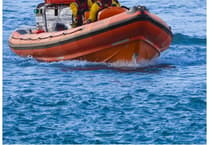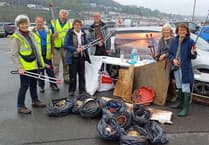THE long-awaited public inquiry into the proposed £4-million expansion of Teignmouth docks opens in Bitton House next Tuesday.
The inquiry, to be conducted by government planning inspector Mike Ellison, is scheduled to last for eight days. The proceedings, which are open to the public, will start at 10am each day and last though until 5pm.
To cater for the new generation of larger ships now in service, and to keep Teignmouth viable, Associated British Ports (ABP) wants to fill in the port's No 1 dock, and build a new wider and straighter quay and a new public slipway at Polly Steps.
It also plans to increase the port's warehouse and storage space.
ABP says that its application for a harbour revision order is supported by an environmental report, verified with the Environment Agency, compiled after nearly a year of detailed research into the Teign estuary and its surroundings, as well as thorough consultations with the harbour authorities, other river users and local residents.
Not surprisingly the proposals have generated controversy and many rumours, forcing the company to issue a lengthy statement in advance of the inquiry.
It has denied that the development would lead to an increase in road traffic. A company spokesperson said: 'Only about one per cent of traffic on local roads is port related and with the development in place, this will increase by only a small amount. 'The existing views from the port across the Teign Estuary will not be affected by the development. Over 10 years ago, ABP made a commitment not to build on the site of the No 2 dock, which was infilled during 1992. ABP still stands by this pledge. ABP has existing powers to extend storage sheds and the Harbour Revision Order will provide powers for an additional extension.'
The spokesperson said that a brand-new, larger slipway to replace the existing Polly Steps slipway, which was in need of repair, would be built by ABP about 20m closer to Shaldon Bridge.
'This will enable an extension to the port quay to be built on the land freed by the relocation of Polly Steps. The quay's new western face will provide, for the first time, 20m of vertical wall, which will come under the control of Teignbridge Council.'
The spokesperson said that the proposed development would not result in any increase in water levels in the estuary, and hence would not increase the risk of flooding in the town. Indeed, she said, ABP was committed to help protect the town from the risk of future flooding by accommodating the Environment Agency's plans for sea defences.
'The effects of the proposed development on the estuary system have been thoroughly investigated,' she said. 'The key finding is that changes in tidal properties will be limited to the outer estuary in the vicinity of the port and there are no detrimental effects on the Salty. There will be a very small loss of intertidal habitat from the western end of the development and ABP, in agreement with Teignbridge Council, will provide suitable compensation in the form of habitat-enhancement work elsewhere in the estuary.'
The spokesperson denied as a 'complete myth' the allegation that there was an intention to build on or dredge the Salty
'ABP's proposals have been deliberately designed to avoid any affect on the Salty,' she said. 'Neither is it ABP's intention to sell off port land eventually for housing development once it has acquired the additional land for the quay reconstruction.'
The extra land would be purchased from the Crown Estate and would have a covenant on it that precluded such development. The extra land being created was the minimum necessary to sustain the current port business.
The new quay reconstruction would not result in the loss of moorings in the estuary.
'After consultations with the Teignmouth Harbour Commission, it has been decided to move and realign a number of moorings which will actually create space for additional moorings,' said the spokesperson.
She denied that the new development gave ABP increased powers of direction to do with as it pleased.
'ABP will not be able, for example, to create an industrial park,' she said. 'ABP will have to operate, as it has done and still does today, within the perimeters of existing legislation and harbour by-laws. ABP's statutory powers only allow it to construct buildings for port-related purposes. ABP does not have, nor is seeking powers, to use the port estate for general industrial purposes.'
It is this last point that most concerns opponents of the development, such as the Teignmouth Action Group.
In January 2003 the group attacked the proposals, saying that they would turn a historic harbour into yet another industrial estate. They pointed out that in 2002 Mole Valley Farmers had set up a feed-bagging operation at a dedicated site in the port.
They argued that ABP wanted powers enabling it to let buildings and land to whomever it chose.
Bob Shaw, a group spokesman, said that the proposed large industrial buildings would look completely out of place on the banks of the Teign.
'A fundamental part of our quarrel with ABP is that they now intend to build another industrial-sized shed, regardless of what the people of Teignmouth think,' he said. 'They've gone about it a heavy-handed way – we are the all-powerful ABP.
'The old Teignmouth Quay Company was once a vital part of the town, but those days have long since gone. Profits and employment brought tremendous local benefits, but Teignmouth is now a residential and holiday place.'
Mr Shaw said that ABP had encroached on a historic public right of way to Polly Steps, built for the use of the people of Teignmouth.
'DCC is sitting on the fence and failing in its duty to keep public highways free of all public nuisances,' he said.
Currently Teignmouth handles 650,000 tonnes of cargo a year, has five working berths, and can take vessels up to 120m in length and up to 5m draught. The proposed straight-line quay would create three new berths of 100m in length.
Teignmouth imports a wide variety of feedstuff products from Europe and South America, as well as a variety of other bulk products such as stone chippings, salt and forest products.
The port's principal export is ball clay from the Bovey Basin quarries of WBB Minerals and Imery's.




.jpeg?width=209&height=140&crop=209:145,smart&quality=75)